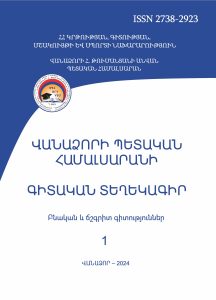The Rates of Natural Regrowth
Scientific Proceedings of Vanadzor State University Natural and Exact Sciences (ISSN 2738-2923)
2024 vol 1
The Rates of Natural Regrowth of Fagus orientalis L. Species in Forest Coexistences of Gugark Region of Lori Marz
Zaruhi Vardanyan Heghine Mkhitaryan
Summary

Key words: deforestation, test site, natural regrowth, seed regrowth, seed shoot, beech tree
In the replacement of beech forests, the role of anthropogenic factors is clearly observed: unplanned, massive deforestation, uncontrolled grazing of livestock, illegal seizure of land and allocation of land for agricultural work, collection of seeds, etc.
The vacated areas of cut beech trees are “occupied” by tall grasses. The bio-ecological characteristics of the Fagus orientalis L. tree in Gugark region of Lori marz in Northern Armenia were studied. Beech groves extend to the upper forest line, where they occur as sparse or isolated low-growing trees. For the assessment of the natural seed state of beech, test plots were set aside. Each test site includes 15-25 measuring platforms with an area 40m2 (on 1 ha), which are arranged in rows at 10-20m. The total area of the test site was 500-1000m2.
The conducted studies showed that there is no trunk regrowth of plants in cut beech trees, and seed regrowth is very slow. As the height of the seed shoots increases, the number of beech individuals decreases: 27.25 times in the 1st experimental plot, and 13 times — in the 2nd. The total number of Eastern beech seed shoots in experimental site No. 1 by 2.91 times exceeds the number recorded in experimental site No. 2. It is consistent that the number of seeds of Fagus orientalis L. in the mixed beech area was less than in the pure beech.
DOI: https://di.org/10.58726/27382923-ne2024.1-80
